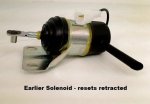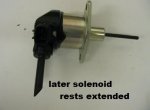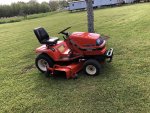certain equipment and other brands using Kubota engines still use the external top mounted solenoids.
It is a dumb design! It works. Or more specifically it works most of the time.
On the newer ones the solenoid is at rest (not powered) with the engine running. When you turn the engine off it applies +12v to the solenoid via wires, fuse, and controller (aka "combination box") to retract the solenoid, which pulls the lever on the injection pump, which pulls the rack to the "no injection" position, therefore stopping the engine. It ain't gonna run if it ain't gettin no fuel.
IMO this style should all have a mechanical means to shut the engine off, external user-controlled lever and cable, a rod, whatever. Some of the older stuff had it/them.
Here is my issue with the design. Many of the earlier units, and some even to this day, have poor wiring. These units all get operated in dirty dusty nasty sometimes wet conditions and a lot of them don't get no lovin, they just stay dirty all the time. So what happens? The connections aren't sealed (I wish they all were), they get dirt in them then they corrode. Since the system works by application of +12v to shut the engine off, if for some reason a connection don't connect, or bad ground, or failed combination box or combination of one or more of those, the engine don't shut off. So if you roll the machine over, there's possibility that the fuse can fall out, and it won't die like it's supposed to. Second issue here is the CCV system. A lot of yall call it a pcv system. The government says that crankcase vapors can no longer be vented to the atmosphere, so no draft tubes are allowed. The vapors must be vented back into the engine. Well what they do is run a hose from the valve cover over to either the intake manifold or to the turbocharger compressor inlet. Great right? If you roll the machine, it will get oil into the intake tract. A diesel don't got any spark plugs (obviously), and needs air, compression and a combustible fuel to run. Most diesels will run on their own crankcase lube oil. So if you turn one upside down, and the oil from the crankcase/valve cover gets into the intake tract, the engine will continue to run regardless of whether or not the shutoff solenoid works. You can take it's fuel supply completely away and it will run until it either (1) runs out of oil (2) seizes up or (3) destroys itself--and I have seen all 3 happen. It is a safety issue that the government never thought about when it comes to diesel engines. I watched a BX tractor roll off an embankment, land upside down on the rollbar and loader (which was up in the air as high as it would go--probably why it rolled), and it sat there upside down, smoking like a freight train, running on it's own lube oil, for over 20 minutes. Mind you that when it's ingesting lube oil, there ain't no governor so this thing had to be running 5000 rpm. It finally kicked a rod out and even after that it still was trying to run, just was so low on power and having a rod rattling around it just couldn't self-sustain. Dangerous situation particularly on mowing equipment with spinning blades that will remove appendages in short order.
I owned (and loved) a G1900. Good mower. The biggest problem with those things was the wiring. It sucks. It sucked from day one. It gets nasty, dirty, corroded, the combination box dies, and it won't turn off when you take the key out. So you had to raise the hood and do one of two things: (1) reach up really close to the spinning fan and grab the shutoff lever and pull it to turn it off or (2) take the intake hose out of it's little placeholder and put your hand over the end of it until the engine died--assuming it didn't have no air leaks at the clamps/hoses. This was very very common on a lot of the old G series, and the T1600 too. GR's still use the design although the combination box is a little better. If the air intake leaked? LOL refer to #1 because it wouldn't die it'd just run rough and smoky. That was my only complaint with my G series, other than lack of available parts (I needed a deck for it). If it weren't for the wiring and combination box problems (and the deck) I'd still have it. A friend knew I had it and the deck was starting to get kinda bad, so I called him and said hey you want to buy a mower? $2300 later, he's a new owner of a good diesel mower--and he still mows with it (3 years later). Its' in dire need of a deck now though and none are to be found that aren't rusted bent broken or just junk.
Much of the updated stuff is completely different. They've gone to use of a block mounted 2 stage solenoid that needs +12v to keep the engine running, which is what they should have been using for ages. It doesn't solve rollover runaways, but it does solve the poor wiring and combination box failure. If you lose power to this style the engine is gonna stop. This applies to sub 25hp engines. Over 25hp, they are all electronically injected (with the exception of the B3350 and the ZD1511), so when you take power away from the ecu via a safety switch or key switch, it is not going to start, or run, period. Just like a EFI gas car. To solve rollover runaways, it's easy enough to incorporate a butterfly throttle valve in the intake to cut the air supply off on mechanical engines. And, by doing this is also reduces the compression pressure as the engine is turned off, so it doesn't kick back nearly as hard when the engine is shut off. Think: Old dodge 5.9 diesels-when you shut those things off they'd continue to turn until a certain point, then they'd abruptly reverse direction because a cylinder would be compressing a bunch of air, which acts like a spring, forces the piston back down the hole, turns the crank backwards, and causes the accessory drive belt to "chirp". Reducing the air going into the engine drastically reduces this issue. It would be beneficial on all of the sub 25hp mechanical engines, and would certainly be a bit of a safety feature should one of them get on it's lid. No air? No run. Oil or fuel either one.






